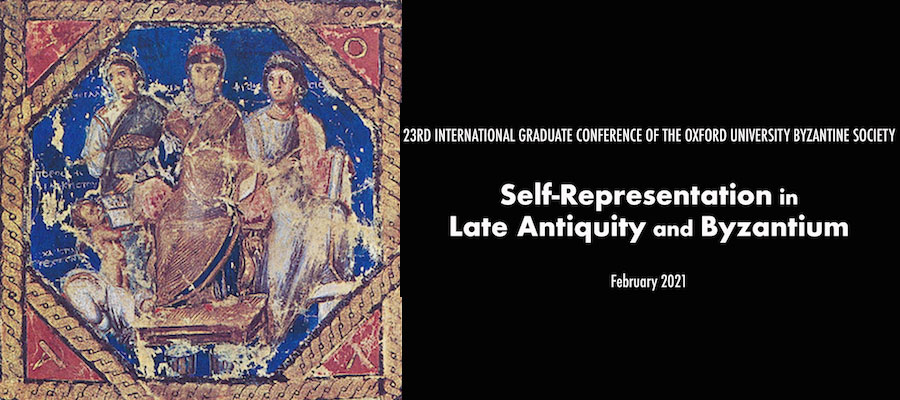Self-Representation in Late Antiquity and Byzantium, 23rd International Graduate Conference of the Oxford University Byzantine Society, February 26–28, 2021
Self-representation is a process by which historical actors – individuals, communities and institutions – fashioned and presented a complex image of themselves through various media.
Referring to Byzantine portraits, Spatharakis claimed that this “form of representation cannot be divorced from its purpose and the requirements of the society in which the given visual language gains currency”. Equally, self-representation provides an original way to interpret the past, because this artificial and reflected image cannot be divorced from the cultural, social, economic, religious and political context of its time. As a methodological tool, it has received increasing attention in the field of Late Antique and Byzantine Studies, following the interest it has created in neighbouring fields such as Western Medieval or Early Modern studies.
The present call for papers aims to explore the cultural outputs of the Late Antique and Byzantine world – e.g. architecture, material culture, literary works – which conventionally or unconventionally can be understood as acts of self-representation. The Late Antique and Byzantine world was filled with voices and images trying to present and represent an idea of self. Some of the most famous examples of this are the lavish mosaics sponsored by imperial and aristocratic patrons, whose splendour still dazzles their observers and gives an idea of the kind of self-fashioning that they embody. Urban elites, such as churchmen, bureaucrats and intellectuals, constructed idealised personae through their literary works and the careful compilation of letter collections, while provincial elites displayed their power through sigillographic imagery and inscriptions. In monastic typika, the founders presented themselves as pious benefactors, while donor epigraphy in rural churches secured the local influence of wealthier peasants. However, self-representation is not only a matter of introspection but also of dialogue with the “other”: such as in the case of spolia, which was used to reincorporate a supposed classical past in one’s self-portrayal, or to create an image of continuity by conquerors. We see this clearly in the conscious use of Byzantine motifs in Islamicate architecture, in the fiction of Digenes Akritas, and in the anti-Jewish and anti-Islamic religious polemics of Late Byzantium. Through depicting what they were not, historical actors were (consciously or unconsciously) shaping their own identity.
This conference, to be held in late February 2021, seeks to join the ongoing dialogue on self-representation in Late Antique and Byzantine Studies by providing a forum for postgraduate and early-career scholars to reflect on this theme in a variety of cultural media. In doing so, we hope to facilitate the interaction and engagement of historians, philologists, archaeologists, art historians, theologians and specialists in material culture. To that end, we encourage submissions from all graduate students and young researchers, encompassing, but not limited to, the following themes:
- Literary works: self-portrayal in epistolographical collections; autobiographies; fictional personae in poetical and prose compositions; typika portraying an image of a founder or donor;
- Portrayal of oneself in terms of gender and sexuality;
- Epigraphy: material sponsored by both authorities and private citizens; self-representation on funerary artefacts, graffiti, inscriptions;
- Numismatics: representation of power and authority in the world of Late Antiquity and Byzantium at large;
- Sigillography: elite self-representation and its importance among the Byzantine upper classes;
- Artistic production: portrayals in mosaics and icons; private and public forms of representation;
- Gift-giving: Elite items (e.g. cloths, manuscripts, jewellery) intended for use in diplomatic exchange which were designed to promote a specific image of an emperor and the empire;
- Political ideology: imperial or ecclesiastical messaging through literary works and monumental architecture;
- Religion: different theological or philosophical stances, dogmatic truths or polemics as means of self-promotion or self-portrayal;
- Dialogue with “the other”: Byzantium’s influence in neighbouring cultures as a consequence of its self-representation;
- Reception: how the field of Late Antique and Byzantine Studies is influenced by the modern-day reception of the self-representation of historical actors;
- Reception: how the field of Late Antique and Byzantine Studies is influenced by historical Western conceptions of the Late Antique and Byzantine world;
- Comparative perspectives of the above elsewhere, in opposition or concordance with practices in Byzantium.
